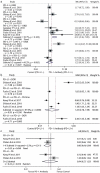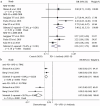Efficacy and safety of immune checkpoint inhibitors in advanced gastric or gastroesophageal junction cancer: a systematic review and meta-analysis
- PMID: 31069144
- PMCID: PMC6492970
- DOI: 10.1080/2162402X.2019.1581547
Efficacy and safety of immune checkpoint inhibitors in advanced gastric or gastroesophageal junction cancer: a systematic review and meta-analysis
Abstract
Background: Immune checkpoint inhibitors (ICI) have shown promising prospects in gastroesophageal junction (G/GEJ) cancer immunotherapy, many clinical trials have been carried out. Objective: To evaluate the efficacy and safety of ICI in G/GEJ cancer. Methods: The published English articles of PubMed, Cochrane Library, Embase, Web of Science were searched up to 30/09/2018. The efficacy and safety of ICI were analyzed by meta-analysis. Results: A total of 2003 patients from nine clinical trials were included. Anti-PD-1 treatment improved the 12-month, 18-month overall survival (OS) rate (RR, 1.79 p = 0.013; 2.20 p = 0.011) and prolonged the duration of response (DOR) (MSR, 3.27 p < 0.001). The objective response rate (ORR) in PD-L1+ patients was greater than PD-L1- (RR, 4.31 p < 0.001). Microsatellite instability-high (MSI-H) patients had higher ORR and disease control rate (DCR) than microsatellite stability (MSS) (RR, 3.40 p< 0.001; 2.26 p= 0.001). The most common grade ≥3 treatment-related adverse events (TRAEs) were fatigue, aspartate aminotransferase increased, hepatitis, pneumonitis, colitis, hypopituitarism. The TRAE incidence of anti-PD-1/PD-L1 was less than chemotherapy (TRAE RR = 0.64 p< 0.001; ≥3 TRAE RR = 0.37 p < 0.001). The incidence of ≥3 TRAEs of anti-PD-1/PD-L1 treatment was less than that of anti-CTLA-4 (11.7% vs 43.9%). Conclusions: ICI treatment could improve some but not all survival endpoints to advanced or metastatic G/GEJ cancer patients suggesting modest benefit and less adverse reactions. Anti-PD-1/PD-L1 therapy was more effective to PD-L1+, MSI-H, EBV+, or high tumor mutational burden patients.
Keywords: CTLA-4; Immune checkpoint inhibitor; PD-1; PD-L1; gastric or gastroesophageal junction cancer; meta-analysis.
Figures






References
-
- Zhang X, Li M, Chen S, Hu J, Guo Q, Liu R, Zheng H, Jin Z, Yuan Y, Xi Y, et al. Endoscopic screening in Asian countries is associated with reduced gastric cancer mortality: a meta-analysis and systematic review. Gastroenterology. 2018;155(347–354.e9). doi:10.1053/j.gastro.2018.04.026. - DOI - PubMed
-
- National Comprehensive Cancer Network NCCN clinical practice guidelines in oncology (NCCN guidelines): gastric cancer. version 2. 2018. May22,2018.
Publication types
LinkOut - more resources
Full Text Sources
Research Materials
